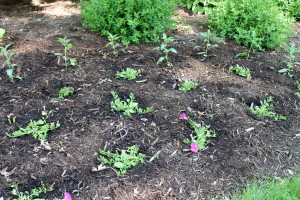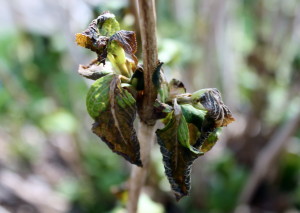Blame It On the Weather
May 31st, 2016
I’ve been getting a swarm of plant-growth questions in the past couple of weeks. Actually, non-plant-growth questions is more like it.

These newly planted petunias are just sitting there sulking in an unusually cool, wet May.
Readers are reporting corn seeds that didn’t sprout, clematis leaves that are sickly yellow, peppers that are just sitting there in pause mode, and sycamore trees that have completely defoliated.
In short, it hasn’t been a great May for plants… at least not like the glorious growth month it usually is.
All or most of the trouble is related to the cool, cloudy, drizzly, wet weather we had for most of the month.
Soggy soil can rot roots, seeds and bulbs. Constantly wet leaves are more prone to fungal diseases. And the lack of sun has deprived plants of the fuel they need to generate growth energy.
As I’ve been telling people, once we get a string of warm and sunny days, I think most of the problems will correct themselves.
The exception is seeds and plants that rotted. If they died or were damaged badly enough, your only recourse is to plant again. Or go without.
Check out the PennLive garden column “How Does Your Garden Grow? Not So Much So Far” that I wrote last week for more on our slow start and what to make of it.
More than a few followers of Murphy’s Law (me included) were saying, “You know what’s going to happen next, right? We’ll go from ridiculously cool to unbearably hot.” (See my list of 10 Murphy’s Laws That Apply to Gardening.)
Sure enough, the operator of our climate thermostat decided to suddenly crank it up early last week. Daytime highs went from the mid-50s to near 90.
I had our heat turned on last Sunday. By last Thursday, it was set to A/C.
Plants don’t like that kind of erratic change any more than we do. And they can’t turn on the A/C.
Many of them need time to adapt and react. Plants do much better when the seasons happen as and when they’re supposed to and when change occurs gradually.
A sudden shift is a shock, and plants often let you know they’re not happy about it by wilting or sulking or dropping leaves.

These young hydrangea leaves got zapped by a post-Mother’s-Day frost.
Our poor plants get confused by weather that just can’t make up its mind, which explains why we saw forsythias blooming in December and hydrangea buds zapped by a fakeout early warmup followed by a late frost.
Since last fall, we’ve had spring in December, a few weeks of real winter, then May in March, then late March for most of May, then July over the Memorial Day weekend.
The good news is that most plants are resilient. They do their best to survive, even though they sometimes swing and miss at the many curveballs Mother Nature throws.
So if things aren’t looking the greatest around your landscape at the moment, don’t fret.
For one thing, you’re not alone.
For another, if the weather “normals out” in June, we’ll catch up. If not, check back next month for Round 2 of 2016 weather whining.







